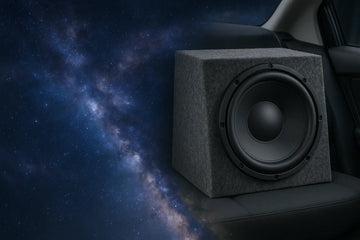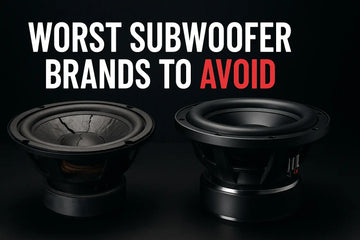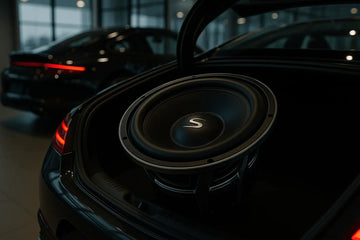Subwoofers are crucial in delivering low-frequency sound reproduction in audio systems, whether for home theater setups, car audio, or high-end audio equipment. The speaker cone material is one of the key components responsible for the subwoofer's performance. The choice of cone material can significantly impact the subwoofer's sound quality, frequency response, and durability. This comprehensive guide will explore the best materials for subwoofer cones, their characteristics, and the factors to consider when selecting the best cone material for your subwoofer.
Discover what goes into making quality bass. Read our ultimate guide on Car Subwoofer Materials to understand the difference materials make.
Understanding the Role of Subwoofer Cone Materials
When the subwoofer's voice coil produces sound waves, it causes the speaker cone to vibrate, generating sound waves that we hear as low frequencies. The cone material plays a critical role in this process, as it needs to be rigid enough to accurately reproduce low frequencies while also being flexible to avoid unwanted resonances and distortions. The cone material directly affects the subwoofer's frequency response, tonal qualities, and overall sound characteristics.
Crucial Aspects of Speaker Cones
To understand the importance of cone materials, it's essential to consider two crucial aspects of speaker cones: pistonic motion and frequency response. Pistonic motion refers to the cone's ability to move back and forth in sync with the electrical signal it receives, reproducing sound waves accurately. Cone materials with high stiffness, such as carbon fiber and metal, offer excellent pistonic motion control, resulting in enhanced sound quality. On the other hand, frequency response refers to the cone's ability to reproduce sound across a range of frequencies. Different cone materials have varying frequency response characteristics, impacting the subwoofer's ability to reproduce low frequencies accurately.
Importance of the Right Cone Material
Choosing the suitable cone material is essential for your subwoofer's optimal sound quality. Each cone material has advantages and characteristics, catering to different sound qualities and system requirements. Rigid cone materials, such as carbon fiber, Kevlar, and metal, are famous for subwoofer cones because they can accurately reproduce low frequencies and deliver crisp, tight bass. On the other hand, cone materials with low mass, like paper and polypropylene, offer improved frequency response and tonal qualities, ideal for midrange frequencies. Selecting the ideal cone material ensures that your subwoofer delivers the desired sound characteristics and audio experience.
An in-depth look at Different Materials for Subwoofer Cones
Now, let's look at the materials commonly used for subwoofer cones. Each material has its characteristics, advantages, and drawbacks, contributing to the subwoofer's overall performance. By understanding these materials, you can make an informed decision when selecting the cone material for your subwoofer.
Paper Cones and Their Characteristics
Paper cones are among the most common materials used for subwoofer cones. They offer an excellent balance between stiffness and flexibility, allowing for accurate pistonic motion. The internal damping properties of paper cones help reduce unwanted resonances, resulting in smooth frequency response. Paper cones are often used in home theater and car audio systems, where they excel at reproducing midrange frequencies. Additionally, paper cones provide environmental resistance, making them suitable for real-world applications. Soft paper cones, in particular, can produce warm, rich sound, ideal for those seeking a smooth, natural audio experience.
The Benefits and Drawbacks of Polypropylene Cones
Polypropylene cones, made of plastic, are popular choices for subwoofer cones due to their durability and lightweight. These cones offer comprehensive frequency response, making them ideal for reproducing high frequencies accurately. However, they may lack the tonal warmth of paper cones. Polypropylene cones handle high volumes and speeds, making them suitable for car audio systems and applications where dynamic response is essential. Their durable nature makes them resistant to environmental factors, ensuring consistent performance over time and contributing to their popularity among subwoofer enthusiasts.
The Durability of Kevlar Cones
Kevlar cones, made from aramid fiber, are known for their exceptional durability and resistance to environmental factors. The high stiffness of Kevlar cones makes them suitable for subwoofers that require accurately handling high volumes and reproducing low frequencies. Kevlar cones also provide internal damping, which helps reduce unwanted resonances and improve sound quality. These cones are popular choices for in-car audio systems, where ruggedness is essential. Kevlar cones maintain sound quality even under extreme conditions, ensuring reliable performance in diverse audio setups.
The Strength of Metal Cones
Metal cones, mainly made from materials like aluminum, offer high stiffness and strength, making them ideal for subwoofers demanding high performance. The rigidity of metal cones allows them to reproduce low frequencies, delivering powerful bass accurately. Metal cones also exhibit internal damping characteristics, helping control unwanted resonances for improved sound quality. They resist temperature changes, ensuring consistent performance even in varying environmental conditions. Due to their excellent sound characteristics and frequency response, metal cones are commonly used in high-end audio equipment, where audio enthusiasts seek the best possible sound reproduction.
The Advantages of Carbon Fiber Cones
Carbon fiber cones have gained popularity in high-end audio systems due to their numerous advantages:
- High stiffness and internal damping characteristics allow for accurate reproduction of low frequencies.
- Light weight contributes to improved frequency response and system efficiency.
- Superior durability ensures long-lasting performance and resistance to environmental factors.
- Carbon fiber cones offer excellent environmental resistance, making them ideal for real-world applications.
- Their rigid material properties enhance sound characteristics and tonal qualities, perfect for high-end audio enthusiasts.
What are the different materials used for subwoofer cones?
Subwoofer cones are typically made from various materials, including paper, polypropylene, aluminum, and composite materials like Kevlar or carbon fiber. Each material has its own unique characteristics and can affect the sound quality and performance of the subwoofer.
Comparing Paper and Polypropylene Cones
Let's compare two popular cone materials, paper and polypropylene, to understand their key features and sound quality differences in subwoofer applications.
Comparing Key Features
Paper cones and polypropylene cones have distinct features that cater to different sound system requirements:
- Paper cones offer excellent pistonic motion and tonal qualities, making them ideal for reproducing midrange frequencies. They are commonly used in home theater and car audio systems.
- Polypropylene cones, on the other hand, excel at handling high frequencies accurately. They offer comprehensive frequency response but may lack the tonal warmth of paper cones, making them a popular choice for subwoofers in car audio setups.
Sound Quality Differences
The choice of cone material significantly impacts the sound quality of the subwoofer.
- With their ideal balance of stiffness and flexibility, paper cones offer warm and rich tonal qualities, providing a smooth and natural audio experience.
- Polypropylene cones, while delivering comprehensive frequency response, may have a slightly different tonal signature, lacking some of the warmth provided by paper cones. However, they excel at reproducing high frequencies accurately, making them popular choices in car audio setups.
Factors Affecting Choice of Cone Material
When selecting the cone material for your subwoofer, several factors should be considered to ensure optimal performance and sound quality.
Considering Environmental Resistance
Environmental factors, such as temperature changes and humidity, can affect the long-term performance of subwoofer cones. Choosing cone materials that withstand these conditions is crucial for durable audio solutions. Cone materials with high resistance to environmental factors ensure consistent sound quality and reliability in various audio equipment setups.
Balancing Flexibility and Rigidity
The ideal cone material should strike a balance between flexibility and rigidity. This balance ensures accurate pistonic motion while minimizing unwanted resonances. Materials with high stiffness, such as carbon fiber and metal, provide excellent rigidity, enhancing sound reproduction. Conversely, materials with low mass, such as paper and polypropylene, offer improved flexibility, contributing to improved frequency response. Balancing flexibility and rigidity in cone material selection is vital to achieving optimal sound quality across the subwoofer's frequency range.
Cone Material's Influence on Subwoofer Performance
The cone material directly influences the subwoofer's response to unwanted frequencies and real-world performance. Selecting the appropriate cone material can enhance the subwoofer's sound quality, frequency response, and tonal characteristics.
How Does the Subwoofer Cone Material Affect Sound Quality?
The subwoofer cone material is crucial in determining the subwoofer's sound quality and tonal characteristics. Different cone materials offer various sound characteristics, catering to different audio system requirements. The choice of cone material impacts several factors, including frequency response, tonal qualities, and system efficiency. Key ways in which cone material affects sound quality include:
- Reproducing sound waves accurately: The cone's ability to move back and forth in perfect pistonic motion, as influenced by its material, ensures accurate sound reproduction.
- Enhancing low frequencies: Rigid cone materials, such as carbon fiber, Kevlar, and metal, accurately reproduce low frequencies, delivering tight, powerful bass.
- Controlling resonances: Cone materials with internal damping characteristics, like paper and Kevlar, help control unwanted resonances, resulting in smoother frequency response and improved sound quality.
- Response to unwanted frequencies: The choice of cone material directly affects the subwoofer's response to unwanted frequencies, ensuring unwanted sounds are minimized.
- Wide variety of sound characteristics: Each cone material offers unique sound characteristics, allowing audio enthusiasts to choose the type of sound qualityquality they prefer, whether warm and rich or crisp and detailed.
- By carefully considering the cone material, you can fine-tune your subwoofer's sound characteristics, creating an immersive audio experience that suits your preferences.
Conclusion
In conclusion, choosing subwoofer cone material is crucial in determining your audio system's overall sound quality and performance. Each material has its unique characteristics, benefits, and drawbacks. Paper cones offer a warm and natural sound, while polypropylene cones provide durability and affordability. Kevlar cones are known for their excellent strength and rigidity, while metal cones offer enhanced power handling capabilities.
Carbon fiber cones combine the best of both worlds with their lightweight yet rigid construction. When selecting a cone material, it is essential to consider factors such as environmental resistance and the desired balance between flexibility and rigidity. The suitable cone material can significantly enhance your listening experience and ensure optimal performance from your subwoofer.
Lightweight Subwoofer Materials for Cars: The Ultimate Guide
Sustainable Sound: Eco-Friendly Subwoofer Components





